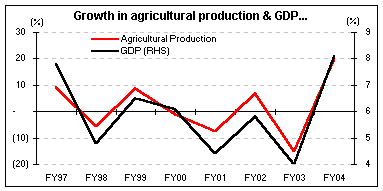
Home > Business > Business Headline > Report
Monsoons: Alarm bells?
July 22, 2004 11:14 IST
Agriculture and allied activities account for nearly one-fourth of India's total output. Industry accounts for another quarter with services accounting for the rest. This should moderate the view that India is an agriculturally driven economy. Nevertheless, the agriculture sector has played a critical role in determining overall growth of our economy.  This is not a coincidence when one considers the fact that a majority of the Indian population (60%) derives its incomes from agricultural and related activities. Although this implies low per capita incomes, it nevertheless adds up to represent tremendous buying power. To put this in perspective, Hindustan Lever, which has a turnover in excess of Rs 100 bn, derives 50% of its revenues from rural areas. And this is just one company. Scores of others have ventured into these markets and found to their surprise the tremendous buying power hidden under the veil of mass poverty. In recent years, GDP growth has been affected by the growth in agricultural sector in no small measure. This is vindicated by the fact that there are many instances in the past wherein despite the slowdown in the industrial sector, our GDP has been lifted from the troughs by the strong performance of the agriculture sector. On the contrary, despite the industrial strength, a below normal agricultural performance has dent our GDP growth. Just to put things in perspective, in FY99, the industrial sector witnessed a slowdown. However, despite this, growth in agriculture lifted overall GDP growth rate to over 6%. On the contrary, despite a respectable industrial sector performance in FY03, our GDP growth was tepid at about 4% owing to adverse performance of the agriculture sector (see chart above). Why are we trying to draw this correlation? In view of the concerns being thrown around of the below normal monsoons and its effect on Indian GDP growth, understanding this historical relationship becomes necessary. As per the Indian Meteorological Department, as on July 14, 2004, out of the 36 meteorogical sub-divisions, rainfall was excess/normal in 20 and deficient in 16 of the sub-divisions. Further, almost 50% of the country's 524 districts are now in a state of deficiency. The cumulative seasonal rainfall in the entire country so far has been 10% below normal. It must be noted that the faltering of monsoons will affect agricultural output as well as industrial sector (as demand cools off). A slowdown in investment activity could further hit economic prospects. This could prove to be detrimental from the point of view of both near-term and long-term growth of our economy. However, the point of comfort for India and Indian investors in all of the above is that the IMD has, as yet, stuck to its forecast of 100% seasonal rainfall of the long period average, i.e. normal monsoons this year. Moreover, just in case, if the monsoons do turn out to be unfavourable, the situation could be salvaged, atleast in part, by the abundant food stocks and foreign currency reserves. And, who knows, the rain Gods may after all bless us! Equitymaster.com is one of India's premier finance portals. The web site offers a user-friendly portfolio tracker, a weekly buy/sell recommendation service and research reports on India's top companies.
|